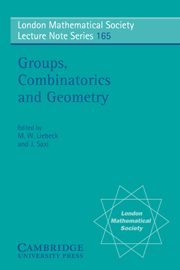Book contents
- Frontmatter
- Contents
- Authors' Addresses
- Introduction
- Part 1 Sporadic groups
- 1 Uniqueness of sporadic groups
- 2 The study of J4 via the theory of uniqueness systems
- 3 Y555 and all that
- 4 Hyperbolic reflections for the Bimonster and 3Fi24
- 5 A geometric characterization of the Monster
- 6 Constructing the Monster
- Part 2 Moonshine
- Part 3 Local and geometric methods in group theory
- Part 4 Geometries and related groups
- Part 5 Finite and algebraic groups of Lie type
- Part 6 Finite permutation groups
- Part 7 Further aspects of simple groups
- Part 8 Related topics
2 - The study of J4 via the theory of uniqueness systems
Published online by Cambridge University Press: 07 September 2010
- Frontmatter
- Contents
- Authors' Addresses
- Introduction
- Part 1 Sporadic groups
- 1 Uniqueness of sporadic groups
- 2 The study of J4 via the theory of uniqueness systems
- 3 Y555 and all that
- 4 Hyperbolic reflections for the Bimonster and 3Fi24
- 5 A geometric characterization of the Monster
- 6 Constructing the Monster
- Part 2 Moonshine
- Part 3 Local and geometric methods in group theory
- Part 4 Geometries and related groups
- Part 5 Finite and algebraic groups of Lie type
- Part 6 Finite permutation groups
- Part 7 Further aspects of simple groups
- Part 8 Related topics
Summary
This article serves as an exposition of the main result of. In we give the first computer free proof of the uniqueness of groups of type J4. In addition we supply simplified proofs of some properties of such groups, such as the structure of certain subgroups.
A group of type J4 is a finite group G possessing an involution z such that H = CG(z) satisfies F*(H) = Q is extraspecial of order 213, H/Q is isomorphic to ℝ3 extended by Aut(M22), and zG ∩ Q ≠ {z}. We prove:
Main TheoremUp to isomorphism there exists at most one group of type J4.
Janko was the first to consider groups of type J4 in, where he established various properties of such groups. For example Janko showed that each group G of type J4 is simple, he determined the order of G, and he described the normalizers of all subgroups of G of prime order. However Janko left open the question of whether there exist groups of type J4 and whether all groups of type J4 are isomorphic. Thus Janko is said to have discovered J4 and indeed J4 was the last of the 26 sporadic simple groups to be discovered.
Around 1980, Conway, Norton, Parker, and Thackray proved the existence and uniqueness of J4 using extensive machine computation. This work is discussed briefly in. Norton et al. construct J4 as a linear group in 112 dimensions over the field of order 2. While the notion of 2-local geometry did not exist at that time, this geometry plays an implicit role in.
- Type
- Chapter
- Information
- Groups, Combinatorics and Geometry , pp. 12 - 21Publisher: Cambridge University PressPrint publication year: 1992

